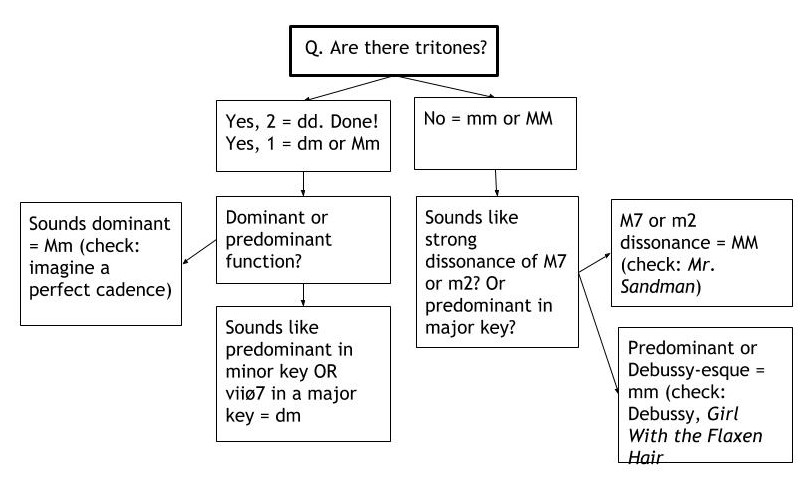Integrated Aural Skills 2019-20
Piano Practice - Figuring Out Inverted Compound Seventh Chords
Methodical Procedures for Quick Answers
When it comes to identifying compound seventh chords in inversions, we need a rational method for quickly sorting through information to find correct answers and identify wrong ones. One such method is a flow chart. In this example, the first question asked is whether tritones are present in the texture. Study the flow chart and use it for the piano practice examples below. Experiment: make your own flow chart with a different initial question.

Piano Practice
Play the following chords on the piano, noticing the intervallic relations between every tone in the chord. Below the examples is the kind of rationale you might use to sort through the evidence to identify your chord quality and inversion.

Rationales
Example (a)
- Perfect 5th between two lower voices: eliminates dd.
- Tritone between two upper voices: eliminates mm and MM.
- Choice is now between dm and Mm. Does this sound like V7 or one of its inversions? (The correct answer is no.) Must be dm.
- Get the inversion: it can’t be root position because there wouldn’t be a perfect 5th. If we think of dm as chord iiø7 in a minor key, the solfege would be “re, fa, le, do.” The only way we can get a perfect 5th is by using fa-do. Therefore, this chord must be dm6/5 (bass note=fa).
- (Check: could you resolve it by improvising a iiø7-V-i progression in A minor on the piano? Take the bass voice up to E=sol, resolve to A=do, follow the usual rules of voice-leading.)
Example (b)
- The dead giveaway here is the major 7th between the top two voices. MM is the only one of the chords we are studying that contains a major 7th. (Check: “Mr. Sandman.”)
- The other dead giveaway is that this chord can’t be in root position. MM is spelled “do, mi, sol, ti,” and do and ti are both taken by the upper voices. Therefore, the chord must have a bass note of either mi (in which case it’s 6/5) or sol (in which case it’s 4/3).
- The two lower pitches are a major 6th apart. A major 6th is an inverted minor third, therefore these two pitches must be sol in the bass voice and mi in the tenor voice. - Therefore, the correct answer is MM 4/3.
Example (c)
- There’s a tritone between the two lowest voices. This eliminates mm and MM, which don’t contain tritones.
- On second hearing, you notice that there’s a perfect fifth between the upper two voices. This eliminates dd, which doesn’t contain perfect consonances. Our choices are narrowed down to dm and Mm.
- You think you can hear the “dominant pull” of the Mm chord, so now all that remains is getting the inversion.
- You think you can hear the root of the chord in the alto voice (you’re right about that), but let’s keep checking to make sure we get the inversion absolutely correct.
- That perfect 5th in the upper two voices must be sol and re of our Mm7 chord (sol-ti-re-fa). Therefore, the two lower voices must be fa in the bass and ti in the tenor. (Check: remember how V 4/2 chords resolve: if fa is in the bass, it must resolve downwards to mi in good voice-leading practice to create V4/2-I6. Can you do this? Yes!)
Further Piano Practice (& Thinking Practice!)
- It is normal to feel unsure when you first attempt the advanced skills involved in identifying compound seventh chords and their inversions. To improve, practice the five types of seventh chords on the piano in all their inversions, voicing them according to good voice-leading procedure (you can review these rules from your Theory IV textbook).
- Questions to ask yourself: “How might this chord appear in harmonic context? How might it resolve? Which note is the bass note?”